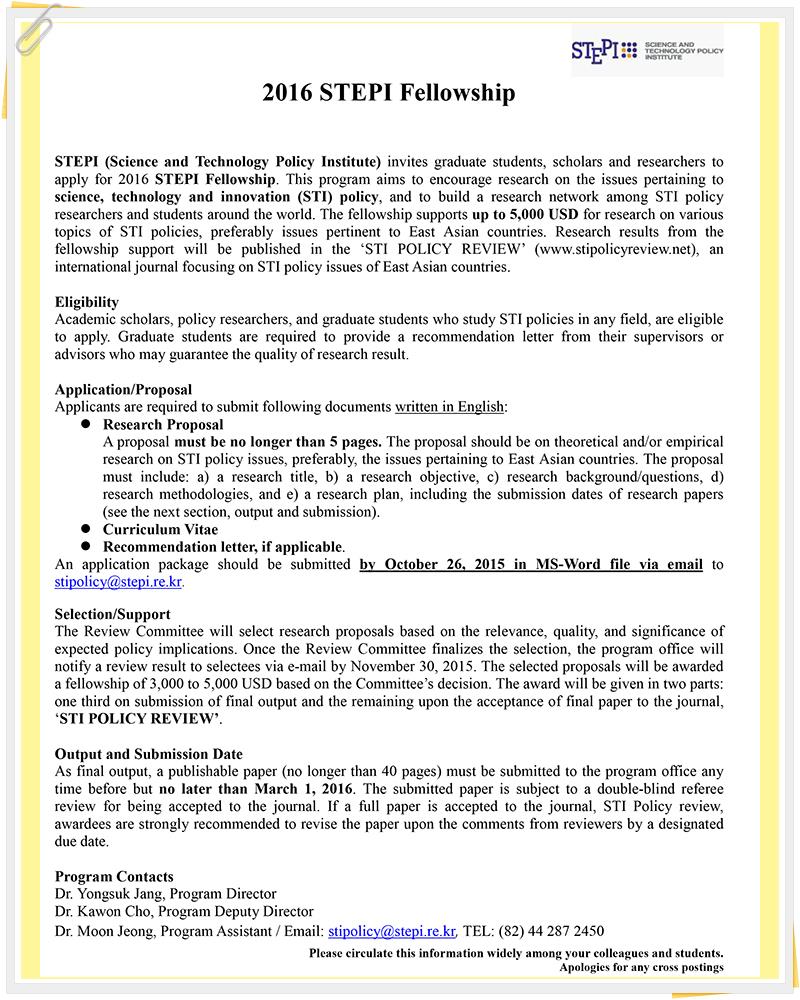Call for DOST-PCHRD - Gruppo Medica Award for Outstanding Undergraduate Thesis in Herbal Medicine
- Details
- Category: Call for Proposals
The DOST-PCHRD - Gruppo Medica Award gives recognition to relevant and innovative research work on herbal medicine undertaken by undergraduate students. The Award highlights research that can lead to practical and/or commercial applications. The Award expects to provide the motivation for students with the technical guidance of their faculty advisers, to view undergraduate thesis not merely as an academic exercise, but as an excellent opportunity to contribute to national interest.
Who can participate
The Award is open to all undergraduate students of Colleges of Pharmacy, Chemistry, Nursing, and Arts and Sciences who have completed thesis projects on medicinal plants. The projects must have been completed within the current school year.
Who can nominate
Nominations must be made by the students' faculty adviser and should be endorsed to DOST-PCHRD by the College Dean and the region-based health research and development consortium. Each institution can endorse a maximum of three (3) thesis projects.
How to nominate
Nominations should be made in a prescribed nominations form stamped with the college seal. Submitted entries must also include the following: (1) Soft and hard copies of the thesis report (2) Plant authentication certification, and (3) Institutional Animal Care and Use Committee (IACUC) certification for researches involving animals and/or Ethical clearance from an Ethics Review Committee for researches involving human participants.
The criteria for the selection are:
| Relevance | 25% |
|
Potential for practical application or commercialization of results |
20% |
| Creativity and originality of research work | 20% |
| Scientific quality | 30% |
| Number of researchers | 5% |
Cash Award
|
First Prize P60,000 |
P42,000 for the student P12,000 for the mentor P6,000 for the school |
|
Second Prize P40,000 |
P28,000 for the student P8,000 for the mentor P4,000 for the school |
|
Third Prize P20,000 |
P14,000 for the student P4,000 for the mentor P2,000 for the school |
Deadline of submission to the consortium is on May 20, 2016.
Click here to download nomination form: http://www.pchrd.dost.gov.ph/index.php/news/events/5085-dost-pchrd-gruppo-medica-award-for-outstanding-undergraduate-thesis-in-herbal-medicine
Region 3 LGUs among Top Performing Users of the eHATID LGU System
- Details
- Category: Latest News
Six (6) local government units in the region were recognized as among the top performing LGUs nationwide. After almost six months of implementation of the eHATID LGU Project, LGU Abucay (Bataan) leads the list at rank #2, followed by LGU Paombong (Bulacan) at rank #3; LGU San Rafael (Bulacan) at rank #5; LGU Bagac (Bataan) at rank #6; LGU Guimba (Nueva Ecija) at rank #10 and LGU Gen. Natividad (Nueva Ecija) at rank #12. Cumulatively, the participating LGUs in the region were recognized as very active in using the online/internet-based capabilities of the eHATID LGU mobile application with roughly 5,000 patient records already uploaded in the cloud-based storage facility.
In recognition of the efforts of these LGUs, the monitoring team led by the Ateneo de Manila University will award a Certificate of Recognition, a Simcard with P1,000 load and ADMU notepad to further assist them in their eHealth-related activities. The team is also planning to provide other incentives for the active usage of the technology to further encourage its utilization. Another review will be done in January 2016 at which time the team is anticipating to find even more active users from the region.
The eHATID LGU project or eHealth TABLET for Informed Decision-Making of Local Government Units (LGUs) have been deployed to 204 LGUs nationwide. It is a health Information system and decision-making support tool provided to LGUs through an Electronic Medical Record (EMR) system that generates particular health reports for the Department of Health (DOH) and the Philippine Health Insurance Corporation (PhilHealth). In Region 3, a total of 33 cities and municipalities have already availed of the tablets.
PCHRD Grants CLHRDC Endorsed Health Research Projects
- Details
- Category: Call for Proposals
The Philippine Council for Health Research and Development (PCHRD) recently approved two health research projects from the Central Luzon Health Research and Development Consortium (CLHRDC) for FY 2015.
The health research projects are entitled: “Canine Rabies Vaccination Outcome Monitoring and its Implication to Rabies Control and Prevention Program in Pampanga” and “Isolation and Molecular Identification of Lactic Acid Bacteria (LAB) from Nile Tilapia (Oreochomis niloticus) as Potential Pathogen Antagonist”. Both projects have a one-year project duration and are from Angeles University Foundation and Pampanga State Agricultural University amounting to P499,445.00 and P445,372.50, respectively.
The assistance is through the Regional Research Fund (RRF) Initiative which is viewed as a way to encourage beginning researchers to be actively involved in health research activities without having to compete with more experienced researchers. These RRF projects are intended to build up the capabilities of individual researchers in designing, implementing and managing health research projects.
CLHRDC continues to accept and review research proposals which address priority health problems/issues identified in the Regional Unified Health Research Agenda (RUHRA) and/or National Unified Health Research Agenda (NUHRA) of the Philippine National Health Research System (PNHRS). Regular staff and faculty members of research institutes, medical and paramedical schools, hospitals and other health related agencies may submit proposals to the consortium, properly endorsed by the head of the agency.
Qualified proposals may also be endorsed by the consortium to other funding agencies such as the DOH-RO III, CHED-RO III and DOST – III.
Bamboo shoot against Fatigue
- Details
- Category: Latest News
Bamboo has been associated to humans since times immemorial. Bamboo belonging to the grass family Poaceae has been known for its vigorous growth and variety of uses. Bamboo from its culms/ stems, barks, shoots, roots and ashes found different uses for different types of men. Bamboo, as a whole, is a staple in Chinese medicine. In the Philippines, it is widely known for its alternative industrial uses. Its shoots, which is used as food especially in Southeast Asia, is commonly known as labong that is known by the locals as a native vegetable which were both eaten by poor and rich men alike.
Over the years, the Philippine Council for Agriculture, Aquatic and Natural Resources (PCAARD) has conducted researchers about bamboo in the purpose of revitalizing the bamboo industry through sustainable bamboo production, management, utilization and marketing to benefit the bamboo growers, processors and the users of quality bamboo finished products. Bamboo has spurred worldwide attention as a versatile plant with multifarious uses. Its uses ranged from subsistence to commercial food (young shoots) , to building and furniture. It offers vital economic and ecological benefits to many people in the world. The provinces selected were Ilocos Norte in Region 1, Pampanga in Region3, Laguna in Region 4, Camarines Sur in Region 5, Iloilo in Region 6, Cebu in Region 7, and Bukidnon in Region 10.
Kawayan tinik [Bambusa blumeana Schultes f.] is the bamboo species chosen for this program, being the species found to possess physical and mechanical properties such as density and strength that are suitable for engineered bamboo products. Currently, kawayan tinik is the dominant species used for the various bamboo derived products (PCAARRD, 2013).
Recently, two active components found in bamboo were proven to fight against fatigue. These were observed in the studies of Zhou and company (2010) at bamboo leave’s flavonoids entitled: “Anti- athletic fatigue activity of flavonoids from bamboo leaves” and Zhang and company (2006) at bamboo shaving’s triterpenoids entitled: “Anti- fatigue activity of a triterpenoid- rich extract from Chinese bamboo shavings (Caulis bamfusae in taeniam)”.
Fatigue may be defined as a situation in which the capacity for work is diminished and efficiency of accomplishment reduced. It is usually accompanied by a feeling of physical or mental tiredness, resulting from severe stress and hard physical or mental work. attention. In the past few decades, health scholars and athletic physiologist have sought nutritional materials and tonic drugs, including natural active products and synthetic chemicals, to improve athletic ability, postpone fatigue and accelerate the elimination of fatigue in human beings (Zhang, 2012).
A study was conducted entitled “Effects of Bamboo (Bambusa blumeana)Shoot Extract on Exercise- Induced Fatigue in ICR Mice (Mus muculus)” by Severino and Supan (2014) graduate high school students of Pampanga State Agricultural University that later on won on the 2nd Symposium on Health Research Projects in Region III held by the Central Luzon Health Research and Development Consortium. In the said study, the mice given with fresh extract lasted for 63.10 minutes of exercise, while the mice given with ethanol and distilled water lasted for 23.01 and 10.31 minutes respectively after letting the mice undergo the exhaustive swimming test. Therefore, saying it is effective against athletic fatigue.
Compared with Gatorade, that runs with carbohydrates and the said electrolytes like sodium, chloride, potassium, and phosphate and which is often questioned for its too much amount of sugar that may fluctuate the blood sugar levels incredibly fast causing you to feel more tired and the presence of larger amount sodium over potassium, if proven bamboo shoot extract can be a natural energy booster which would absolutely benefit farmers and their families which often resolve to harvesting bamboo shoots and adding them to their meals. Bamboo, as said earlier is a grass and can be found almost anywhere.
According to Dr. Virgilio T. Bagunu, director of Pampanga State Agricultural University (PSAU) bamboo and rattan project, a study about the bamboo shoot, specially kawayang tinik, would be a great help in expanding knowledge and possibilities about bamboo shoot since it is a native vegetable in the Philippines and specially knowing the information of the vegetable's toxicity level would help us avoid risks and explore usage. Bamboo shoot has also a high potential in export and has a high demand in food and non-food products.
Capitalizing the current trend of the growing population of Asian ethnic origin and without much effort and capital needed, bamboo shoot production could be a very promising livelihood opportunity, especially in countries like the Philippines where bamboos grow in abundance (PCAARD, 2009).
However, like all amateur researches the anti- fatigue of bamboo shoot has its own drawbacks. The higher the improvement in the tolerance against fatigue the greater the damage it caused in the mice liver, proving toxicity, though it may be because of the saying that anything in excess is poison.
As a result, further studies regarding bamboo shoots are required to gain more knowledge about it to discover probable yet undiscovered health benefits of bamboo which would benefit a huge number in our population.










